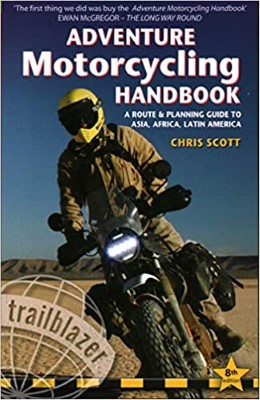 |
|

20 Jan 2003
|
|
Registered Users
HUBB regular
|
|
Join Date: Mar 2001
Location: York, Yorkshire, UK or Cairo, Egypt
Posts: 63
|
|
|
Michelin XZLs
Ive just got hold of a set of XZLs at a bargain price for my new Defender here in Cairo. Im unfamiliar with the type (Ive used XCLs but not here) - they look good for rock and broken ground but Im wary of using them in sand as they look narrow and aggressive. I havent much option though. I have a pair of good Bridgestone VSJs - my query is, should I put the VSJs on the front of the vehicle for control or on the back to spread the load on the sand?
(EDIT... bizarre article I found on the WWW... interesting, if true!
"The XS was considered for years to be the best sand tire available for desert crossings. Testing by Michelin in the Sahara and Saudi deserts showed that the XZL actually had better sand performance, in large part because of reduced rolling resistance (narrower section). This testing was conducted in the late 1980's. Thus the XS tires were discontinued."
Never heard that before!!! Sounds weird to me - less rolling resistance? Narrower section equals cuts through upper sand crust and sinks, surely???
[This message has been edited by LandRoverNomad (edited 20 January 2003).]
__________________
Take nothing but photographs, leave nothing but wheeltracks..... tread lightly.
|

20 Jan 2003
|
|
Registered Users
Veteran HUBBer
|
|
Join Date: Sep 2002
Location: Nottingham, UK
Posts: 180
|
|
|
Yup, that sounds like Michelin marketing-speak to me. I guess I could see some conditions under which a narrower tyre might offer better "performance", but not in a sensible overall comparison.
Regards,
Michael
P.S. I'd put the bigger tyres at the rear, where the load is, myself. But I imagine it might turn into a similar debate to "which wheels would you put a pair of snow chains onto?" i.e. good arguments both ways.
|

20 Jan 2003
|
|
Registered Users
Veteran HUBBer
|
|
Join Date: Apr 2001
Location: Scotland
Posts: 775
|
|
Quote:
Originally posted by LandRoverNomad:
Never heard that before!!! Sounds weird to me - less rolling resistance? Narrower section equals cuts through upper sand crust and sinks, surely???
[This message has been edited by LandRoverNomad (edited 20 January 2003).]
|
Well, it does make sense, if you think again. In the sand, the tyre not only scoops the sand underneath but also pushes a wall of sand in front o it. The wider the tyre, the more sand needs to be pushed, hence more resistance. A well deflated narrow tyre will act as a track without the liability of the resistance described above.
I bought a set of brand new XS's from Nene Tyres or Craddock (cant' remember now) only two years ago, so it doesn't seem to be completely discontinued.
------------------
Roman (UK)
www.polandrover.com
__________________
----------------
Roman (UK)
|

21 Jan 2003
|
|
Registered Users
New on the HUBB
|
|
Join Date: Jan 2003
Location: Germany
Posts: 3
|
|
|
I drove with 4 new XZLs through the Erg Oriental in Algeria last summer and found them as the best tires I ever had, compared to XSFs and Bridgestone VSJs.
LaGirafe
|

21 Jan 2003
|
|
Registered Users
Veteran HUBBer
|
|
Join Date: Sep 2002
Location: Nottingham, UK
Posts: 180
|
|
|
Roman,
Are you seriously arguing that narrower tyres are better in sand than wide ones, other things (diameter, pressure, tread pattern, etc.) being equal?
If so what are the limits of the logic behind that? (From beach-rollers to pram wheels).
I don't think the sand wall will be larger if you use a wide tyre versus a narrow one. The better flotation of the wide tyre will result in a lower sand wall, albeit slightly wider.
Regards,
Michael...
|

22 Jan 2003
|
 |
Registered Users
Veteran HUBBer
|
|
Join Date: Jul 2002
Location: London / IOW
Posts: 486
|
|
|
The idea is that narrower tyres are often taller, giving more flotation (bizarrely).
Also, when lowering pressures tyres deform much more front/back than they do side/side. This means that a tall thin tyre gives a larger footprint when deflated than a squat, wide one would.
V.difficult to explain without diagrams, but look in CS Sahara Overland, and also the Tom Shephard book "Vehicle Dependent Expeditions" available at the RGS in London.
It true though.
|

22 Jan 2003
|
|
Registered Users
Veteran HUBBer
|
|
Join Date: Apr 2001
Location: Scotland
Posts: 775
|
|
Quote:
Originally posted by SandyM:
Roman,
Are you seriously arguing that narrower tyres are better in sand than wide ones, other things (diameter, pressure, tread pattern, etc.) being equal?
|
Yes, I do. I've tried this and it works.
Quote:
If so what are the limits of the logic behind that? (From beach-rollers to pram wheels).
[/B]
|
There's no logic behind lot's of things, like driving 4x4 cars on big fat tyres in Kensington & Chelsea. Still, people do it.
I'm not a geek to argue about hard science but I do know it works. Perhaps one day someone will come up with a well documented study to prove the point. I guess it must have something to do with a balance between flotation, rolling resistance and traction.
Rgds,
Roman (UK)
__________________
----------------
Roman (UK)
|

22 Jan 2003
|
|
Registered Users
Veteran HUBBer
|
|
Join Date: Oct 2001
Location: France
Posts: 353
|
|
Go to http://www.syegon.com/cadrevpggb.htm and click on "aim"; It shows how a taller tyre becomes almost a track. Wide tyres are fine if you have oodles of power, a long footprint at low pressure is less damaging to the fragile crust.
Nice System, that Syegon. Probably very expensive.
Luke
|

22 Jan 2003
|
|
Registered Users
Veteran HUBBer
|
|
Join Date: Jun 2002
Location: Southern England
Posts: 205
|
|
|
On XZL's - I met someone on an off road course here in the UK who had 7.50 XZL's, he did not have any desert experience with them, but did say that they wore alarmingly fast on tarmac (Soft compound?)
On narrow tyres in general - I have Michelin XZY's on my Defender (tread width 6 inches) and in Algeria I found that they had traction at low pressures equal to any of the wider tyred vehicles with us. On a couple of occaisions we just sank into the really soft sand though, and needed a pull out, but that was only twice or so in 3500 desert miles. We were carrying 700kg - too much. I also found that they tramlined in ruts very rapidly. I wish that they did a slightly wider version. That would be ideal.
Friends of mine tell me that with wider tyres, like 265's on a Defender, you won't sink into the soft stuff so much, but you will struggle more up the dunes, the wider tyres causing resistance to forward motion, not a problem as previously mentioned if you have power to spare, or more accurately, a larger capacity engine which is always putting out say 100bhp, unlike a Defender which peaks at 100bhp.
Hope this is some help
Regards,
ANDREW.
|

22 Jan 2003
|
|
Registered Users
Veteran HUBBer
|
|
Join Date: Sep 2002
Location: Nottingham, UK
Posts: 180
|
|
Hi POB,
I have absolutely no argument with what you are saying about a tall narrow tyre versus a short wide tyre. In fact I have several times extolled the virtues of going taller instead of wider. http://www.horizonsunlimited.com/ubb...ML/000662.html .
However, I was trying to find an explanation for Michelin's statement, as quoted by LandRoverNomad. Namely that the replacement tyre was better in sand than the outgoing model, "due in part to a narrower section". Narrowness is (usually) only a benefit in sand if the footprint area is maintained by increasing the diameter or lowering the pressure.
If Michelin's replacement tyres are bigger diameter, or allow lower pressures, then that would explain the claimed improvement. But narrowness itself is not a virtue in sand, since the decrease in the width of the sand wall is more than offset by the significant increase in the height of the sandwall (due to less flotation).
Put another way, compare a 7.50-16 and a 265/75-16, at the same pressure (and with similar tread, etc). Just no comparison, other practicalities aside.
My opinion, based on my own experience and what I have read, (including both the excellent books you cite) is that flotation is by FAR the most important criterion for a sand tyre. That means a big footprint - the bigger the better. A bigger diameter increases the length of the footprint, which is ideal. A wider tyre increases the footprint width, which is good, but carries a slight penalty. And lower pressure increases the length by a lot, and the width by a bit, which is best of all. (One's choice will in practice be determined by other considerations, not related to pure sand performance, of course.)
Roman:
Your experience that narrower tyres are better in sand than wide ones of the same diameter and at the same pressure is very much contrary to my own. I find that a bit odd  I am really not trying to be argumentative here, but just to understand how one of us is wrong. Could you give us an example of specific tyres you have compared?
I have tried both 7.50-16's (XZL) and 235/85-16's (BFG Trac-Edge) on my Discovery, and it made a vast difference, even though the XZL is IMO a better sand tyre.
|

22 Jan 2003
|
|
Registered Users
Veteran HUBBer
|
|
Join Date: Mar 2001
Location: Switzerland
Posts: 332
|
|
|
Experience:
A steep, very soft sandy slope near the village of Tamadjert in Algeria. Vehicles with about the same power ~120hp: 109V8 on 255/85R16MT and Range Rover 3.5L on 7.50R15 Michelin X. The Stage 1 was loaded slightly more then the Range.
The Stage I went up on the first attempt with 1 bar in the tyres. We needed 3 attempts to get the Range to the top - finally at 0.6 bar.
My experience is that the flotation / pressure is the most important factor in soft sand. So I support Sandys school of thaught. In dunes I prefer to have tyres with better control (less sidewards slipping) then the typical desert tyres, so prefer MT's or AT's.
One important point: check your tyre specs. small tyres like 235/85R16 are not specified for high loads at low preassure! With a 285/75R16 you gain about 30% compared with an 235/85R16
Here some figures:
Max load per tyre ofroad for BFG Radial AT and MT)
preassure 1.2 1.4 1.8 bar
235/85 R16 310 360 460
255/85 R16 360 425 545
265/75 R16 375 435 560
285/75 R16 400 465 600
33x9.50 R15 385 450 575
32x11.50R15 390 460 590
Increase of admitted load for slow speeds
km/h faktor
80 1.1
60 1.17
40 1.3
30 1.5
20 2
10 4
Bye, Yves
__________________
Yves
|

22 Jan 2003
|
|
Registered Users
Veteran HUBBer
|
|
Join Date: Sep 2002
Location: Nottingham, UK
Posts: 180
|
|
|
Yves:
Very good stuff on the pressure/load info. May I ask where you found it?
Tom Sheppard, in "The Land Rover Experience" lists some allowable cold tyre pressures for various Land Rovers.
A 110, with 7.50-16 XZLs or XSs, pressure in Bars (100kPa).
Unladen, Road pressure: Front 1.8, Rear 2.0
Unladen, emergency flotation (20kmph max), F 1.1, R 1.2
Fully laden, Road: F 1.9, R 3.3
Fully Laden, emergency flotation (20kmph max): F 1.1, R 2.0
This would seem to agree with your figures, broadly speaking.
Regards,
Michael
|

23 Jan 2003
|
|
Registered Users
Veteran HUBBer
|
|
Join Date: Apr 2001
Location: Scotland
Posts: 775
|
|
Quote:
Originally posted by SandyM:
I have tried both 7.50-16's (XZL) and 235/85-16's (BFG Trac-Edge) on my Discovery, and it made a vast difference, even though the XZL is IMO a better sand tyre.
|
Michael,
Size-wise, these are very similar tyres, so the vast difference must come from somewhere else. I've also tried BGF on sand and it is acceptable, but being a tyre with stiffer sidewals it can be deflated to, say 10-12 psi, only for short runs. Otherwise it quickly gets pretty hot and pops off the rim. The XS could run like this for miles.
Also, no matter how wide your tyres are, they are only as good as the rubber they are made of. If you run out of spare tyres, your best bet is to get a replacement locally. With 7.50x16 being probably the most popular size in 3W countries, you run the risk of ending up with only three impressively fat sand tyres.
Rgds,
Roman
__________________
----------------
Roman (UK)
|

23 Jan 2003
|
|
Registered Users
Veteran HUBBer
|
|
Join Date: Mar 2001
Location: Switzerland
Posts: 332
|
|
|
Hi Michael,
the figures are from the BFG Offroad Tyre "Ratgeber" 2000
Bye, Yves
__________________
Yves
|

23 Jan 2003
|
|
Registered Users
Veteran HUBBer
|
|
Join Date: Sep 2002
Location: Nottingham, UK
Posts: 180
|
|
|
Hi again Roman,
The 235/85 is the same diameter as the 7.50, but more than 20% wider - a good inch and half to two inches!. Hence its superior flotation at the same pressure.
I know that both the XS and the XZL are designed to run at lower pressures than the BFGs - that's part of what makes them inherently better sand tyres. If their narrowness was an additional advantage, they would be infinitely superior to the wider 235s. But they are not, my wider BFGs were significantly better, especially in the softer sand.
While I take your point about the availability advantages of 7.50-16s, I was only comparing the wider and narrower tyres in the context of their sand performance, not their suitability from other points of view.
I personally would opt for Michelins for any desert expedition, and I would select the biggest diameter tyre that would reasonably fit my vehicle, but my choice would be biased towards a 31 inch diamter tyre so that I could use a 7.50-16 in an emergency.
Regards,
M...
[This message has been edited by SandyM (edited 22 January 2003).]
|
|
Currently Active Users Viewing This Thread: 1 (0 Registered Users and/or Members and 1 guests)
|
|
|
 Posting Rules
Posting Rules
|
You may not post new threads
You may not post replies
You may not post attachments
You may not edit your posts
HTML code is Off
|
|
|
|

Check the RAW segments; Grant, your HU host is on every month!
Episodes below to listen to while you, err, pretend to do something or other...

2020 Edition of Chris Scott's Adventure Motorcycling Handbook.
"Ultimate global guide for red-blooded bikers planning overseas exploration. Covers choice & preparation of best bike, shipping overseas, baggage design, riding techniques, travel health, visas, documentation, safety and useful addresses." Recommended. (Grant)

Ripcord Rescue Travel Insurance™ combines into a single integrated program the best evacuation and rescue with the premier travel insurance coverages designed for adventurers.
Led by special operations veterans, Stanford Medicine affiliated physicians, paramedics and other travel experts, Ripcord is perfect for adventure seekers, climbers, skiers, sports enthusiasts, hunters, international travelers, humanitarian efforts, expeditions and more.
Ripcord travel protection is now available for ALL nationalities, and travel is covered on motorcycles of all sizes!
What others say about HU...
"This site is the BIBLE for international bike travelers." Greg, Australia
"Thank you! The web site, The travels, The insight, The inspiration, Everything, just thanks." Colin, UK
"My friend and I are planning a trip from Singapore to England... We found (the HU) site invaluable as an aid to planning and have based a lot of our purchases (bikes, riding gear, etc.) on what we have learned from this site." Phil, Australia
"I for one always had an adventurous spirit, but you and Susan lit the fire for my trip and I'll be forever grateful for what you two do to inspire others to just do it." Brent, USA
"Your website is a mecca of valuable information and the (video) series is informative, entertaining, and inspiring!" Jennifer, Canada
"Your worldwide organisation and events are the Go To places to for all serious touring and aspiring touring bikers." Trevor, South Africa
"This is the answer to all my questions." Haydn, Australia
"Keep going the excellent work you are doing for Horizons Unlimited - I love it!" Thomas, Germany
Lots more comments here!

Diaries of a compulsive traveller
by Graham Field
Book, eBook, Audiobook
"A compelling, honest, inspiring and entertaining writing style with a built-in feel-good factor" Get them NOW from the authors' website and Amazon.com, Amazon.ca, Amazon.co.uk.
Back Road Map Books and Backroad GPS Maps for all of Canada - a must have!
New to Horizons Unlimited?
New to motorcycle travelling? New to the HU site? Confused? Too many options? It's really very simple - just 4 easy steps!
Horizons Unlimited was founded in 1997 by Grant and Susan Johnson following their journey around the world on a BMW R80G/S.
 Read more about Grant & Susan's story
Read more about Grant & Susan's story
Membership - help keep us going!
Horizons Unlimited is not a big multi-national company, just two people who love motorcycle travel and have grown what started as a hobby in 1997 into a full time job (usually 8-10 hours per day and 7 days a week) and a labour of love. To keep it going and a roof over our heads, we run events all over the world with the help of volunteers; we sell inspirational and informative DVDs; we have a few selected advertisers; and we make a small amount from memberships.
You don't have to be a Member to come to an HU meeting, access the website, or ask questions on the HUBB. What you get for your membership contribution is our sincere gratitude, good karma and knowing that you're helping to keep the motorcycle travel dream alive. Contributing Members and Gold Members do get additional features on the HUBB. Here's a list of all the Member benefits on the HUBB.
|
|
|